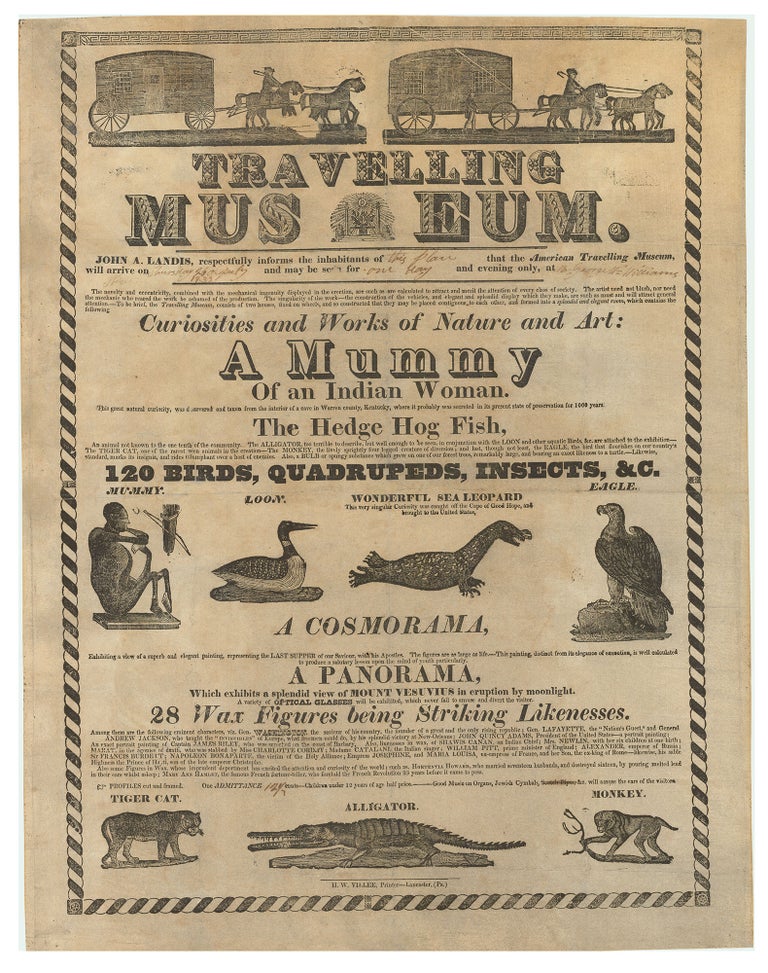Travelling Museum…Curiosities and Works of Nature and Art: A Mummy of an Indian Woman…The Hedge Hog Fish…
Lancaster, Pa.: H. W. Villee, printer, [circa 1832]. Illustrated broadside, 25.5” x 19.5”, text and 10 wood-engravings (two initialed “H”) within ornamental border, blanks completed in manuscript. Recently reinforced on verso with Japanese tissue. A marvelous, unrecorded broadside advertising a traveling museum on tour in Pennylvania in 1832, exhibiting a mummy, a host of apparently stuffed animals, two panoramic paintings, wax figures, and other curiosities. The proprietor, John A. Landis, announces that “the Travelling Museum, consists of two houses, fixed on wheels, and so constructed that they may be placed contiguous to each other, and formed into a splendid and elegant room” which contains “Curiosities and Works of Nature and Art.” These include “a mummy of an Indian woman…taken from a cave in Warren county, Kentucky, where it probably was secreted in its present state of preservation for 1000 years”; a “hedge hog fish”; “120 birds, quadrupeds, insects, &c”; a “Cosmorama” (evidently a panorama with cosmic implications) of the Last Supper; a panoramic painting of Mount Vesuvius “erupting by moonlight”; and wax figures of such luminaries as George Washington, Gen. Lafayette, Andrew Jackson, Marat “in the agonies of death, who was stabbed by Miss Charlotte Corday,” and Hortentia Howard, “who married seventeen husbands, and destroyed sixteen, by pouring melted lead in their ears whilst asleep.” In addition to the various curiosities and works of art exhibited, music was performed on organs and “Jewish Cymbals,” as noted in the final line of text. Ordinarily, scotch pipes would have been played as well, but this has been crossed out, evidently indicating that the pipe player missed the tour. Also advertised in the last line is the cutting and framing of profile portraits. A delightful array of wood engravings illustrate the broadside. Appearing at the top are two similar images intended to represent the “houses” Landis describes (each effectively half a room), situated on horse-drawn wagons, which must have been drawn up beside each other to form the complete exhibition space, although it is difficult to imagine everything described here being effectively exhibited in the space thus formed. The other engravings include a Masonic symbol, the mummy (accompanied by a bow and quiver of arrows), a loon, a “wonderful sea leopard caught off the Cape of Good Hope and brought to the United States,” an eagle, a tiger, an alligator, and a monkey. Landis’s mummy—evidently the main attraction of the museum—was very likely one of a number of Native American mummies discovered in Mammoth Cave and nearby Short Cave in the first quarter of the nineteenth century. The most famous of these, the so-called Fawn Hoof mummy, appeared in Scudder’s Museum in New York as well as other exhibitions and suffered much damage before it was deposited at the American Antiquarian Society, and later transferred to the Smithsonian. This broadside and the later history of Landis’s museum give some indication of the fate of another mummy removed from the Mammoth Cave region. John A. Landis, an innkeeper in Lancaster, Pennsylvania, announced to the public in October of 1819 that he had collected “a large number of natural and artificial curiosities” for a museum and formally opened his doors in December, occupying a building on “West Street, opposite the theatre,” the first of four Lancaster locations. It was open every day except Sunday “from 9 o’clock in the morning until sunset,” admission twenty-five cents. Landis operated the museum until 1839, when he sold it to J. M. Westhaeffer who sold a half interest to Charles S. Getz. The firm of Westhaeffer & Getz ran the museum for three years, when Westhaeffer sold his interest to Getz, who in turn sold the entire affair to Noah Smith at the end of 1842. Smith kept it going until 1849, when he sold it to Wood & Peale of Cincinnati, who moved the collection to their city, where it was destroyed by fire a year later. This broadside is a fascinating piece of evidence regarding the contents of the museum and demonstrates that in addition to operating at a fixed location in town, Landis took his show on the road. Blanks filled in at the top indicate that the museum appeared in the town in which this broadside was posted on Thursday, July 26, 1832 for one day at “Mr George W. Williams.” The town is not named, but simply referred to as “this place,” presumably a small town in the greater Lancaster region. No copies recorded in OCLC of this or any other broadsides advertising Landis’s museum. A rare and most desirable traveling museum broadside. CONDITION: Good, loss to horses legs in engraving at top left (hole filled from behind), old folds and creases flattened, repairs to a few small breaks, mainly along folds. REFERENCES: Ellis, Franklin and Samuel Evans. History of Lancaster County, Pennsylvania (Philadelphia, 1883), p. 436; Baker, David. Nahum Ward and the Fawn Hoof Mummy at earlymarietta.blogspot.com.
Item #6361
Sold


